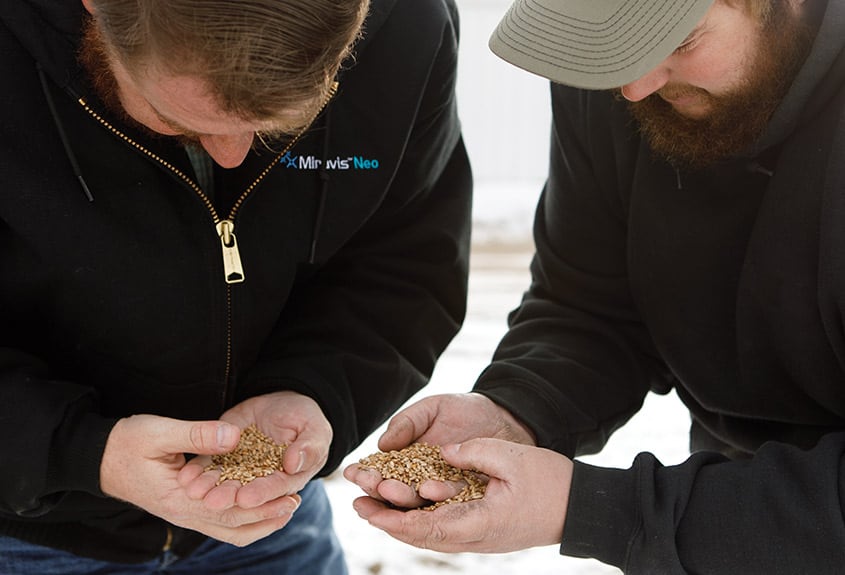Prevention Is the Best Cure for Crop Diseases

click to tweet ![]()
Starting the Year Right
Given the wet weather in 2019, growers are especially on guard for disease outbreaks this spring. That’s because many corn, soybean and wheat diseases — even trace amounts of inoculum in fields — can overwinter, waiting for the right conditions to reemerge and wreak havoc on yields.
To prevent last year’s yield-robbing diseases from reappearing, growers can take a proactive approach, which starts with carefully selecting the right hybrid or variety for their farm. Growers can also implement crop rotation so they are not growing their crops in fields with elevated fungal populations from the previous year.
“Rotating to nonhost crops is crucial to breaking up disease cycles, but it is not enough,” says Eric Tedford, Ph.D., technical product lead for Syngenta. “Since some pathogens can overwinter for many years on crop residue, growers need to implement more forceful tactics.”
Selecting the Right Fungicide
One of the most important tactics growers can deploy is selecting the right fungicide for their specific crop, Tedford says.
-
In Corn — Corn growers have two excellent weapons in their battle against high inoculum levels. Since agronomists expect the pathogens that cause tar spot and Fusarium ear rot to overwinter, growers can count on Miravis® Neo fungicide to help protect their corn from these aggressive diseases. The fungicide also offers excellent control of Northern corn leaf blight and gray leaf spot, among other diseases.
“Miravis Neo is a three-way mix of powerful active ingredients, including Adepidyn® fungicide,” Tedford explains. “It equips growers with disease control they can bank on and offers plant-health benefits.”
Trivapro® fungicide is another equally hardworking, long-lasting option. “Trivapro works overtime in the field with the best efficacy I’ve seen on common and Southern rust,” says Brett Johnson, fungicide product lead for Syngenta. “It also delivers exceptional control of gray leaf spot and Northern corn leaf blight.” -
In Soybeans — For soybeans, growers have two powerful options in the Miravis family to fight against disease. To protect against overwintering white mold and brown spot, Miravis Neo is an excellent option.
“We haven’t seen a product like Miravis Neo that offers the same level of plant-health benefits and white mold suppression,” says Griffin Schaub, a sales agronomist for Prinsburg Farmers Cooperative in Prinsburg, Minnesota. “It has brought an extra element to the farm that really gives us trust in the product, its flexibility and its performance.”
Additionally, Southern soybean growers have another fungicide in their toolbox. Miravis Top is custom-built to control the toughest soybean diseases, including target spot, strobilurin-resistant frogeye leaf spot and brown spot.
“Southern soybean growers experience tough conditions each year,” Johnson says. “But Miravis Top is specifically engineered to take on those challenges, protect yield and optimize income potential.” -
In Wheat — To combat head scab, wheat growers can turn to Miravis Ace for superior disease control. After applying Miravis Ace to his wheat in 2019, North Dakota grower Cameron Schulz saw a 3-bushel per acre yield increase. “That’s in addition to experiencing unique application flexibility because Miravis Ace also widens the application window by allowing applications from as early as 50% head emergence up to flowering,” notes Nathan Popiel, the Syngenta agronomic service representative for Schultz.
“I would recommend Miravis Ace because it just works,” Schulz says. “Growers who didn't spray had a lot of head scab last year. We didn't get any because of Miravis Ace.”
Looking Back to Move Ahead
In 2019, many growers were taken by surprise when weather conditions took a turn for the worse and never seemed to let up. The year began with a cold, wet spring, forcing many growers to plant late, replant or not plant at all. This combination of sustained bad weather into the summer months led to an increase in heavy disease pressure across many geographies and took a significant toll on yields because crops didn’t reach their full genetic potential.
Corn growers saw more gray leaf spot and tar spot than in previous years. Soybean growers fought a fierce battle against white mold and target spot, and wheat growers saw Fusarium head blight or head scab in numerous fields. For those who didn’t apply fungicides, the unanticipated weather conditions throughout the spring and summer, combined with high disease pressure, significantly damaged their crop quality and yield.“2019 was a challenging year, but it was the year where fungicides really paid dividends. As the 2020 season gets underway, I recommend keeping an eye on that rearview mirror and remembering what happened in 2019.”
But growers who applied a preventive fungicide, such as Trivapro in corn or the Miravis family of brands across a variety of crops, saw significantly less disease presence and damage to their fields.
“2019 was a challenging year, but it was the year where fungicides really paid dividends,” Popiel says. “As the 2020 season gets underway, I recommend keeping an eye on that rearview mirror and remembering what happened in 2019. Risk is always out there, and you always want to prepare yourself and be protected.”

